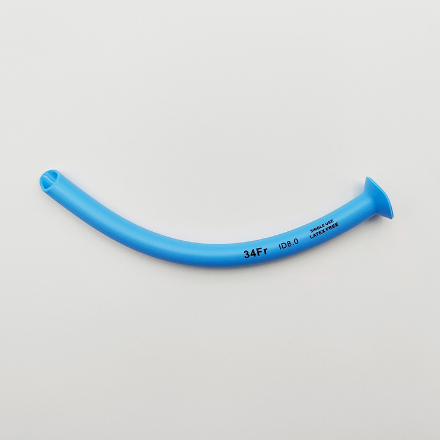TEl: +86-13148388090
Fax:+86-571-88616515
When to Use a Nasopharyngeal Airway
Author: admin / 2024-08-05A nasopharyngeal airway (NPA) is a thin, clear, flexible tube that can be inserted through the nasal passage down into the posterior pharynx to ensure airway patency. A healthcare provider needs to know when to use a nasopharyngeal airway because appropriate use of a nasopharyngeal airway has a significant impact on patient care.
An obstructed upper airway is not a condition; the obstruction may happen at the nose, nasopharynx, or base of the tongue. The nasopharyngeal airway (NPA) is specifically designed to solve this problem of the patient. The airway can be used in neonates and adults.
Illustration of the correctly inserted nasopharyngeal airway (extends from the tip of the nose to the posterior pharynx)

A typical nasopharyngeal airway
When to use a nasopharyngeal airway
Regarding medical patients:
Given any of the following indications, the healthcare provider will be able to determine the need to use a nasopharyngeal airway:
1) If the patient has an obstructed upper airway, causing him respiratory distress.
2) Seizure management: During a seizure, a patient may experience airway compromise. Inserting an NPA can help maintain an open airway and facilitate better oxygenation during the seizure.
3) Trismus (Lockjaw): A patient with a trismus problem will not be able to open his/her mouth due to muscle spasms or rigidity. An NPA can be used in this case if he/she cannot open the mouth.
4) Facial injury: If the patient has a severe injury to his/her face which causes loss of oral airways, an NPA can be used to provide airway patency.
5) Anesthesia and sedation: Drugs for anesthesia or sedation effects may result in airway compromise; in this case, an NPA can be used for airway patency.
6) Sometimes in an emergency incident the person suffers from an obstructed airway; an NPA can be used to maintain his/her airway patency if oropharyngeal airway is not an option.
Regarding surgical patients
There is a possibility that the patient undergoes airway obstruction after an operation. An NPA can be inserted if this is deemed necessary to maintain an open airway.
1) Micrognathia associated with congenital syndromes (Pierre Robin sequence, Treacher Collins, or Stickler Syndrome).
2) Patients with muscular dystrophy or other syndromes affecting the airway (Velocardiofacial syndrome, Stickler syndrome, Treacher Collins Syndrome, etc)
3) Patients who have pre-existing obstructive sleep apnoea or whose upper airway structures are expected to become swollen after operation (palate repair, pharyngoplasty, tongue surgery, etc.)
4) Patients have airway obstruction with loss of pharyngeal tone following induction of anesthesia.
An NPA is generally only required for the night after an operation. It can generally be removed the next day.
Contraindications and precautions
Not all patients can have an NPA inserted because they may have conditions that do not allow NPA to be used on them. If any of the following is the case, it constitutes a contraindication.
A. If the patient has a basilar skull fracture, there is a chance that the insertion of the NPA may penetrate the cranial cavity.
B. NPA insertion requires the patient’s possession of certain conditions, for example, he/she does not have severe nasal trauma or deformity; otherwise the insertion may cause injuries.
C. a person who has recently undergone nasal surgery should not receive NPA insertion lest the insertion action negatively affect the surgical part and cause complications.
Advice on how the NPA insertion is to be performed
See if the oropharynx is obstructed by secretions, vomitus, or foreign matter. If so clear them off.
Determine the appropriate size of the nasopharyngeal airway. The airway is supposed to extend from the tip of the nose to the tragus of the ear.
The nasopharyngeal airway needs to be sufficiently lubricated.
Insert the airway posteriorly (not cephalad) parallel to the floor of the nasal cavity, with the bevel of the tip facing toward the nasal septum (ie, with the pointed end lateral and the open end of the airway facing the septum). Use gentle yet firm pressure to pass the airway through the nasal cavity under the inferior turbinate.
If resistance is encountered, try rotating it slightly. If this does not help, use the other nostril for insertion.
Equipment for nasopharyngeal airway
1) Gloves and gown
2) Devices used for placing neck and head into sniffing position
3) Nasopharyngeal airways (various sizes)
4) Lubricants
5) Suctioning apparatus and other devices to clear the pharynx
6) Nasogastric tube to relieve gastric insufflation
conclusion
We’ve discussed when to use a nasopharyngeal airway in the passages above. It is also important to note that the performance and quality of a nasopharyngeal airway are crucially important as these have a great impact on patient healthcare. When choosing a nasopharyngeal airway we need to be concerned with the airway’s certifications, material used, design features, size, etc. For detailed information on nasopharyngeal airways, you can refer to useful websites such as this one: www.bevermedical.com


